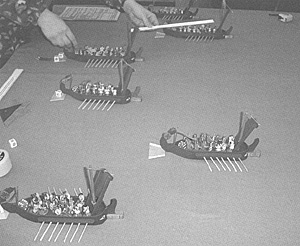 This rule set may be used to play Ancient Naval Battles using individually mounted figures and scratch-built galleys. These rules are a re-hash of other sets I have seen. Since I already owned a pile of ancient lead in 25mm, I modified the rules and scratch-built my own ships. Other scales (15mm to 1/72) could be used without altering the rules.
This rule set may be used to play Ancient Naval Battles using individually mounted figures and scratch-built galleys. These rules are a re-hash of other sets I have seen. Since I already owned a pile of ancient lead in 25mm, I modified the rules and scratch-built my own ships. Other scales (15mm to 1/72) could be used without altering the rules.
Quite a number of play tests over about 10 years and some lively discussion defined and clarified the following rules and game mechanics. The result is a real "beer & pretzel" game that is fast and fun to play. Games involving 4 to 6 players, and using from 8 to 12 galleys, only last two or three hours.
Additional copies of these rules are available at a nominal cost. Mike Barratt, 245 Nile Street, Stratford, Ontario, Canada N5A 4G 1 - (519) 2732955
GAME SET-UP
I recommend a minimum of 4 to 6 galleys per side using a 4-by-8 foot or 5-by-8 foot table. Players can easily manage 1 to 3 ships.
I crew small ships with 1 slinger, 2 archers & 7-8 melee troops. I crew larger ships with 1 slinger, 2 archers & up to 10-12 melee troops. The fleet admiral gets extra figures, 1 standard bearer & 1 musician. Some ships may be equipped with a ballista or Roman ships with the corvus.
You will need: model ships with removable oars (some wooden coffee stir sticks are perfectly shaped for this), 25mm figures on round 3/4" bases, 25mm Ballista models, lots of six-sided dice (d6), wake markers to indicate speed, match-sticks to indicate hull-damage, 45 degree turn/ramming template rulers to measure movement.
GENERAL OUTLINE OF THE SEQUENCE OF PLAY
At the start of each game turn, Roll a d6 for each galley. This die roll sets initiative/movement priority for the game turn. The fleet admiral for each side rolls two d6, to determine his flag-ship's initiative. The fleet admiral with the higher total of two d6 receives a little baton and has the final say if a dispute over movement/melee priority arises for the game turn. Each galley Moves, Rams and/or Grapples sequentially.
These actions may be performed once, in any order, by each galley according to it's initiative/movement priority. Galleys with the lower die-rolls move first. If a conflict occurs over moving first among enemy galleys with the same die-roll, the fleet admiral with the baton has the final say.
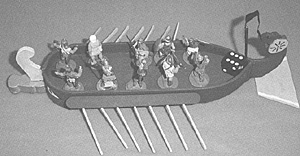 After each galley has moved, take it's movement die off the table so there will be no confusion over who has already moved, or who will move next. Continue until all ships in both fleets have moved. Galleys may: move in Reverse, be Stopped, or move forward at any one of three forward speeds: Cruising Speed, Battle Speed or Ramming Speed. Galleys may ram the enemy, subject to: galley size, stamina of the rowers, distance traveled, and the angle/location of the ram. Then assess damage for new ram attacks and glances. Ships that suffer collision, glancing and/or ramming must come to a full stop and may not move until the next turn. Galleys may attempt to grapple the enemy, and the enemy may attempt to fend off. Friendly grapples are automatic and friendly transfer of crew occurs during movement, with the limitation of not exceeding the receiving ship's original complement.
After each galley has moved, take it's movement die off the table so there will be no confusion over who has already moved, or who will move next. Continue until all ships in both fleets have moved. Galleys may: move in Reverse, be Stopped, or move forward at any one of three forward speeds: Cruising Speed, Battle Speed or Ramming Speed. Galleys may ram the enemy, subject to: galley size, stamina of the rowers, distance traveled, and the angle/location of the ram. Then assess damage for new ram attacks and glances. Ships that suffer collision, glancing and/or ramming must come to a full stop and may not move until the next turn. Galleys may attempt to grapple the enemy, and the enemy may attempt to fend off. Friendly grapples are automatic and friendly transfer of crew occurs during movement, with the limitation of not exceeding the receiving ship's original complement.
The Missile Fire Phase is simultaneous. Each galley receives one missile fire attempt per game turn consisting of ballista, archers & slingers. You may divide fire between one or more targets. Target galleys may receive missile fire from one or more enemies, and the results are cumulative. Casualties caused by missile fire do not miss their fire phase. Tip them over on the deck. If eligible, you may include these figures in any return missile fire. After all the galleys have fired, set the casualties aside in the casualty box. They will be used for Victory Point Determination.
Removing sunken galleys: Galleys that accumulate 6 points of hull damage, sink and are replaced by a flotsam/wreck marker prior to the melee phase. Any crew trapped aboard a sunken galley, will drown automatically and are also removed from play.
The Melee Phase is simultaneous and each melee continues to the death. The captured ships may be abandoned or become prizes. A Prize must be crewed by a minimum prize crew of `one' and then be sailed off the nearest friendly table edge. Prizes that get away successfully are used for victory point determination.
SEQUENCE OF PLAY
- INITIATIVE PHASE (Roll a d6 for each galley) (Fleet Admiral rolls two d6)
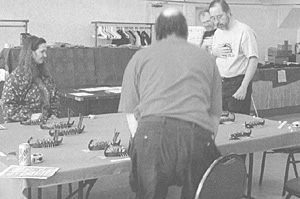 TEST FOR HULL DAMAGE (Previously damaged ships must beat their current H.D. on a die-roll of one d6 and add +1/+2 if you fail)
TEST FOR HULL DAMAGE (Previously damaged ships must beat their current H.D. on a die-roll of one d6 and add +1/+2 if you fail)
MOVEMENT, GRAPPLING AND/OR RAMMING PHASE (each galley, in turn, may move, grapple and/or ram)
MISSILE FIRE PHASE (simultaneous)
REMOVE SUNKEN GALLEYS (after all missile fire, replace with Flotsam/wreck markers)
MELEE PHASE (simultaneous)
CAPTURED GALLEYS/PRIZES (lower flags on captured ships, abandon them or plan to sail off prizes)
INITIATIVE
Roll a d6 for each galley at the start of each game turn, and place it on the table near the galley's stern. This die roll sets initiative/movement priority for the game turn.
The fleet admiral for each side rolls two d6. He may choose to use either die-roll for his initiative. He need not reveal his intentions until he actually moves.
In addition, each turn the fleet admiral with the higher total of his two d6, has the final say if a dispute over movement/melee priority arises. Give the fleet admiral a little baton to signify that he has the final say for that particular game turn.
TEST FOR HULL DAMAGE
Previously damaged galleys test for additional hull damage. Roll a d6 for each galley. If the result is higher than the current hull damage (H.D.), there is no effect. If the result is equal, then add one additional point of H.D. If the result is lower, add two additional points of H.D. This simulates the cumulative effect of flooding and structural damage.
Any galley which has now accumulated 6 points of hull damage will be removed from play right after the missile fire phase. Then it is replaced by a flotsam/wreck template. Any crew still aboard a sunken galley, will drown and will also be removed from play. Drowned crew are placed into the casualty box for victory point determination. (See section 5 on ramming.)
MOVEMENT
Each galley Moves, Rams and/or Grapples sequentially until everyone has had a turn. Moving, Ramming and/or Grappling may be performed once only, in any order, by each galley during each game turn according to each ship's initiative/movement priority.
Galleys may move in: Reverse, be Stopped, or move forward at any one of three forward speeds: Cruising Speed, Battle Speed or Ramming Speed.
| MOVEMENT RATES | ||
|---|---|---|
| Speed | Movement | Stamina |
| Stopped | 6 Inches | 0 |
| Cruising | 8 Inches | 0 |
| Battle | 12 Inches | 1 |
| Ramming | 18 Inches | +2 |
Galleys with the lower die-rolls move first. Begin by moving the galley(s) with die rolls of `1', then `2' & so on and so forth up to `6'. If a conflict occurs over moving first among enemy galleys with the same die-roll, then the fleet admiral holding the baton has the final say. Then, re-establish priority and move the galleys in question. Continue until all ships in both fleets have moved. After each galley moves, remove its movement die from the table so there will be no question over who has already moved, or who will move next.
Stamina: The stamina of the rowers is reduced when moving at Battle or Ramming Speed. Each galley begins the game with six stamina points indicated by a d6 in the galley near the stem-post. The Stamina die is checked at the start of each galley's movement to verify that it can complete its move. Adjust the Stamina die immediately after movement. Even though it is not used up, a galley must have a minimum of one stamina point in order to move at all (i.e. Cruising speed or in Reverse).
An exhausted crew can regain one point of stamina if their galley remains stopped and is not touching (not grappled with) an enemy ship. It may never have more than 6 stamina points!
Mandatory Movement Forward: Any galley which did not end it's previous game turn stopped, must move forward a minimum of 4 inches in the following turn before it may turn and/or stop. A galley need not move more than the 4 inch minimum, regardless what forward speed it may have declared.
Mandatory Movement Explained Further: If a galley ended the previous game turn with a minimum 4 inches forward movement, then it may turn immediately before moving forward. To indicate this capability, lay the wake indicator square with the stem if the galley was moving straight 4 inches last turn. Turn the indicator sideways if it did not. No partial move carry over from previous turn!
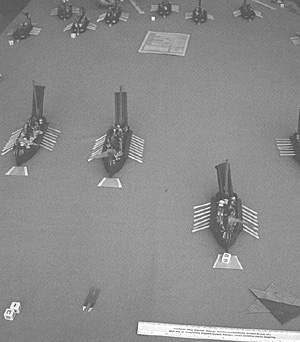 Turning: Any galley which has moved straight ahead for a minimum of 4 inches in the current game turn may perform a turn of up to 45 degrees. After moving at least another 4 inches forward, the galley may make a second turn of up to 45 degrees. (See turning restrictions on galleys equipped with the corvus. See section # 4.08) Make all turns using a 45 degree turning template or a protractor centered amidships on the galley and a maximum of two 45 degree turns are permitted per game turn. Roman Galleys equipped with the corvus, are limited to one 45 degree turn during each game turn.
Turning: Any galley which has moved straight ahead for a minimum of 4 inches in the current game turn may perform a turn of up to 45 degrees. After moving at least another 4 inches forward, the galley may make a second turn of up to 45 degrees. (See turning restrictions on galleys equipped with the corvus. See section # 4.08) Make all turns using a 45 degree turning template or a protractor centered amidships on the galley and a maximum of two 45 degree turns are permitted per game turn. Roman Galleys equipped with the corvus, are limited to one 45 degree turn during each game turn.
Changing Speed: A galley may only change it's speed by one level per turn: i.e. 1reverse, 2-stopped, 3-cruising or 4-battle/ramming. A drop in speed from battle and/or ramming to cruising is equal to one level. Stopping: Regardless of the forward speed being used, a galley may always stop after completing it's mandatory 4 inch movement straight ahead.
Movement of Stopped Galleys: A galley which begins a game turn stopped my do any of the following: a) remain in place and/or pivot up to 90 degrees, b) turn up to 45 degrees and move up to 4 inches forward or in reverse, c) move forward up to 4 inches or in reverse and then turn up to 45 degrees, d) move straight ahead up to 8 inches with no turns, e) move straight back 6 inches with no turns.
Movement at Ramming Speed: A galley must be moving at ramming speed in order to inflict damage upon another galley. Think of ramming speed, as battle speed with an up to 6 inch charge bonus. You pay stamina costs of +1 plus +2 for a total of `3'
A galley that wishes to ram must move 12 inches, completing any required turns. Then the final bonus of up to 6 inches for ramming must go straight in, with no turns.
If the galley continues at ramming speed for a second turn (assuming it has enough stamina points remaining), it must continue straight in, for up to 18 inches with no turns at all.
Oar Damage: If any part of another galley, friend or foe touches the oars of another galley, a full or partial oar-sweep occurs and the contacted vessel's movement may be reduced. Any oar touched is removed from both models. Hull damage and Oar damage can occur simultaneously.
Once a minimum of `3' empty oar sockets appears on one side of a galley, speed is reduced. Therefore, loss of fewer than `3' oars on one side of the model has no effect. The first reduction in speed prohibits the galley from reaching 'Ramming Speed' for the balance of the game.
Once a minimum of `3' empty oar sockets appears on both sides of a galley, then speed is further reduced. The second reduction in speed prohibits the galley from reaching 'Battle-Speed' for the balance of the game. However, it may continue to move about at cruising speed until the caws come home.
Movement through/over a flotsam/wreck marker: The moving ship must slow to Cruising speed and will remain at that speed until clear. Move the ship over the flotsam/wreck marker. Then, immediately test for hull damage, using the same procedure and rules per section 2.
If the moving ship suffered cumulative hull damage at the beginning of the turn, any damage it receives now is also cumulative. In effect, any attempt to move over a flotsam/wreck marker is made at your own peril!
If you sink, what would Caesar or for that matter, your mother say??
GRAPPLING
Grappling may occur during each galley's Move/Ram/ Grapple Phase. One grappling attempt may be made by each galley during each game turn according to each ship's initiative/movement priority.
Note: Successful `full rams' are automatic grapples that cannot be fended off. In order to grapple, a galley must be within 2 inches of the opposing vessel. Move your galley into position and come to a full stop. Measure from the closest part of the hull (including your oar banks), to the closest part of the opposing galley (but excluding the ram and/or the bow/stern posts.) Contact of your oars alone with the enemy's oars may not necessarily bring you close enough.
If you meet the conditions indicated in 4-03, roll a d6 to Grapple. A roll of 4,5,6 lodges the grapple. Note: you may only attempt one grapple per game turn. The opponent may attempt to fend-off. Roll a d6 for each remaining missile figure (excluding the ballista). A roll of 6 fends off the grapple. Finally, a player who wishes to fend off more than one grapple may designate a man to each opponent. If all grapples are successfully cut, the galley is free to use it's movement.
A successful grapple means that both ships remain stationary for at least the rest of the turn . Therefore, a freshly grappled ship, that hasn't moved yet, and hasn't been able to fend off, will not be able to move. Friendly grapples are automatic, and both ships come to a full stop. A friendly transfer of crew may be made. The receiving ship is limited to a maximum crew size equal to its original complement.
To reinforce an allied galley in melee refer to section 08-08.
By definition, an empty ship is a `friendly ship' and may be automatically grappled and/or ungrappled.
Using the Roman Corvus (Boarding Bridge): Place these on Roman Galleys in lieu of ballista. The crew - (melee figures only) may be increased by 10-25%. To achieve play balance, opponents should be given a larger number of smaller (more maneuverable) galleys. Keep the man-power of both fleets on a par. My current models have a corvus with a 2i reach on the small galleys and a 3i reach on the large. Galleys equipped with the corvus may only turn once per game turn. Roman attempts to grapple are automatic on a roll of 2-5 and may not be fended-off.
A roll of 1 is unsuccessful. The Corvus was a single-use weapon. If the roll is unsuccessful, the Roman Galley must come to a stop anyway and the Corvus falls into the sea. After a successful grapple and melee, the Corvus is abandoned when the Roman Galley moves off is search of other prey.
Tactically, the Romans stick together and bludgeon their way through. It's quite effective. The opponent has to use his superior maneuverability to ram and doubleup up on the Romans before the weight of the Roman Juggernaut overwhelms a piecemeal attack.
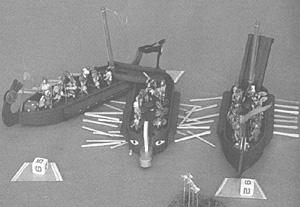 RAMMING
RAMMING
A galley must be moving at ramming speed to inflict any damage. The amount of damage to the rammed vessel varies, subject to: galley size, distance traveled, the angle/location of the ram, and a random die-roll. Think of ramming speed, as battle speed with an up to 6 inch charge bonus. You pay stamina costs of +1 plus +2 for total of `3' Move the first full 12 inches at Battle Speed, completing any required turns. The final bonus move of up to 6 inches must go straight in, with no turns. If the galley continues at ramming speed for a second turn (assuming it has enough stamina points), it must continue straight in, for up to 18 inches with no turns at all.
A ram to the enemy's bow or anywhere in front of the oar banks is a glancing ram causing 1 point of damage. The ramming ship deflects down the side. A small ship can not cause damage to a larger ship with a glancing ram. Rams to the enemy's oar bank at less than 45 degrees, are also a glancing ram, and deflect down the side damaging oars.
After the ramming boat makes contact, determine how much movement remains and halve it. The glancing movement may continue to clip off oars while moving the remaining distance, or the moving ship may stop as soon as it wishes. 05-04 Rams to the oar bank inside of 45 degrees, and anywhere on the stern at any angle are full rams as well as automatic grapples. Hull and Oar damage can occur simultaneously.
A `Full Ram' causes a variable amount of damage. Roll a d6. The total of the dieroll is the number of points of damage inflicted on the enemy. Drop match-stick counters on the deck to signify `each' point of hull damage (H.D.). A galley that sustains six points of hull damage sinks immediately. Even if is has not moved yet.
When attacking a smaller galley, a larger vessel causes 1 point of hull damage on glancing rams, and receives a +1 modifier to the die-roll on full rams.
Collisions: Friendly (at ramming speed) - test for damage and both ships become stopped and end movement.
Friendly (at less than ramming speed) - no damage, but both ships become stopped and end movement.
Unfriendly (at less than ramming speed) - The non-moving galley stays in place, stops and loses it's movement. The moving galley deflects along the side until it damages one or more of its own oars.
MISSILE FIRE
Missile Fire is Simultaneous. Each galley receives one missile-fire attempt per game turn and may divide its fire between one or more targets.
A target galley may receive missile-fire from more than one enemy per game turn and the results are cumulative.
Missile-Fire consists of three types and has varying effect depending upon the range:
| MISSILE FIRE | ||
|---|---|---|
| Type | Short Range | Long Range |
| Ballista | 0-18 Inches | 18-36 Inches |
| Archers | 0-9 Inches | 9-18 Inches |
| Slingers | 0-9 Inches | No Effect |
Ballista Fire: Roll a d6 for each Ballista. A hit is scored on a roll of 6 at long range, or a roll of 4,5,6 at short range.
Effect of Ballista Fire: If a hit was scored roll another d6 for effect.
- 1 = killed an archer/slinger
2,3 = disorganized rowers
4,5,6 = killed a marine.
Killed archers may fire if they have not already done so, and are then removed from play.
Disorganized rowers cause the galley to stop. Remove the speed indicator. There is no permanent damage & no effect on stamina. The galley moves normally next turn.
Killed marines are immediately removed from play.
Archer/Slinger Fire: Roll a d6 for each figure firing. A hit is scored on a roll of 6 at long range, or a roll of 4,5,6 at short range.
Effect of Archer/Slinger Fire: If a hit was scored roll another d6 for effect. 1,2 = killed an archer/slinger 3,4,5,6 = killed a marine.
Killed archers may fire if they have not already done so, and are then removed from play.
Kills on archers/slingers may be taken off against either type, or you may remove the ballista model instead (Owning player's choice).
Killed marines are immediately removed from play.
Casualties caused by missile-fire do not miss their fire phase. As missile-fire casualties occur, tip-over the figures on the deck. If eligible, you may include these figures in any calculations for return missile-fire.
After all galleys have fired, remove the casualties and set them aside in the casualty box. They will be used later for Victory Point Determination.
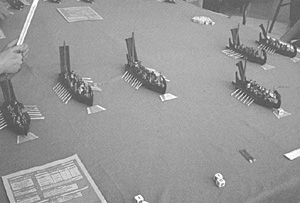 REMOVE SUNKEN GALLEYS
REMOVE SUNKEN GALLEYS
A galley which accumulates 6 points of hull damage sinks and is removed prior to the melee phase. (Also see rule 05-05).
When you remove a sunken galley, mark the spot with a flotsam/wreck marker.
Any crew trapped on board a sunken galley, drown automatically, and are also removed from play. Put them into the casualty box for victory point determination.
MELEE PHASE
The Melee Phase is conducted simultaneously. Only the crews of grappled galleys may participate in the melee. The actual boarding is abstracted. The marines throw their javelins and casualties are taken off. Then the hack and slash continues until the death. Finally captured ships may be taken over as prizes.
Javelin Fire: Roll a d6 for each marine on each side. Count up the Number of 6's per side. You automatically inflict that number of casualties against the enemy. The owning player may choose any type/combination of figures to satisfy this.
Remember the ballista crew is inherent with the model and may also be used as a casualty. (optional) Bear in mind that only marines are able to fight in the hack and slash-fest, and that if you only remove missile troops, you may have no missile capability in future game turns. Finally, only one javelin fire attempt per turn!
Hack & Slash: Roll a d6 for all marines on each side. Count up the number of 5's and 6's per side. Subtract the higher result from the lower. The winner takes no casualties. The loser takes casualties equal to the difference. The owning player may choose any type/combination of figures to satisfy this. Melee continues until only one side is left standing.
A `captured' ship by definition, must have fewer than 5 points of hull damage when it is taken over. Otherwise it is hardly worth the attempt. A prize crew consists of one or more `human' figures. Prize crew transfer, only occurs as a part of the next turn's movement. There is no post melee movement allowed.
The captured ship and prize crew may then attempt to sail off a friendly table edge. They may move at a maximum speed of "Cruising Speed". If they make it, set them aside for victory point determination. If confronted by an enemy, they fight as normal. Prizes may be re-captured repeatedly.
Winners of a melee may only abandon their original ship if it has 4 or more points of hull damage and would most likely sink during the next game turn. Such weakened ships may be sailed off to safety in exactly the same way as prizes.
Reinforcing a melee is accomplished in several ways.
- 1. During movement, perform a friendly out-board grapple and transfer enough crew to bring the receiving ship up to full strength.
2. Melee with an un-even number of in-board galleys. The admiral with the baton designates the melee direction. The out-numbered defender fights a series of alternating melee phases with each attacker. (Kind of like tag-team wrestling!) In other words casualties would be assessed to each attacker in alternating melees phases. Note: the alternate attacker doesn't throw javelins as melee is already underway. Normal melee goes on until only one side is left standing.
3. Melee with an even number of in-board galleys. Two on two melees are not permitted. (Even though such a situation could arise if they were all grappled to each other in a pin-wheel. In this case, make separate one on one attacks using the melee direction indicated by the admiral with the baton.
To maintain balance, no gang-ups may occur unless every opponent in contact is attacked at least once.
If a reinforcing galley is out-board, it's crew can not melee during the current phase. It may reinforce a ship that is about to go into melee(up to it's initial strength) Boarding during melee is abstracted, but actual transfer of crews involves the physical movement of the figures from one ship to another. It is mechanically simpler if out-board ships are only permitted to reinforce a friendly ship, or engage in a separate melee during a later game turn.
VICTORY POINT DETERMINATION
+10 points per surviving small galley/small prize, +15 points per surviving large galley/large prize, +1 point per each surviving crew including prize crew, -1 point per each casualty. The side with the highest result wins!
Present the victorious admiral with the baton. A victory parade with rose petals, much music and dancers is also a nice touch!
Back to MWAN # 131 Table of Contents
Back to MWAN List of Issues
Back to MagWeb Magazine List
© Copyright 2004 Legio X
This article appears in MagWeb.com (Magazine Web) on the Internet World Wide Web.
Other articles from military history and related magazines are available at http://www.magweb.com